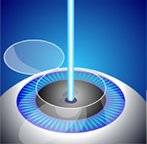LASIK, PRK, AND LASEK
 Laser corrective eye surgery comes in a number of different varieties – LASIK, PRK, and LASEK for example but the overall process is relatively similar. This article will focus on the most common modern procedure – LASIK. The following 3 part progress includes an explanation of what happens before, during, and after the procedure.
Laser corrective eye surgery comes in a number of different varieties – LASIK, PRK, and LASEK for example but the overall process is relatively similar. This article will focus on the most common modern procedure – LASIK. The following 3 part progress includes an explanation of what happens before, during, and after the procedure.
On the day of your procedure, you’ll meet with your Patient Counselor who will help you complete the necessary paperwork and confirm your procedure, service plan choices, payment, as well as your post-operative care.. You will need to ensure that you have a ride home from your procedure. You’ll then get a chance to ask your surgeon any final questions that are on your mind.
Laser Corrective Eye Procedure
The second part of the laser corrective eye surgery process involves the actual procedure. In some cases, this may involve a final test or exam by the doctor to ensure that your eyes are stable. (Note that you’ll also be offered an optional sedative in case you’re nervous and plenty of anesthetics to assure your comfort.)
The surgeon will begin by applying the anesthetic. Next, he will begin to create the LASIK flap, a small flap created in the outermost surface of the cornea that provides access to the corneal bed. Either the Microkeratome or Intralase laser will be used. The Intralase tool is generally used more often since it provides more uniform flap thickness and fewer flap complications.
Next, the cornea will be reshaped so it can more effectively focus light on the retina. Nearsightedness requires the cornea to be flattened, whereas farsightedness calls for steepening. In the case of astigmatism, a laser will be used to correct the cornea’s abnormal shape.
Immediately after the procedure, your vision will be very blurry and the doctor will check your eyes and provide postoperative instructions. You’ll then be asked to rest for a day after being driven home by your friend or family member. Finally, the laser corrective eye procedure process usually ends after you’ve attended all of your follow up visits.
